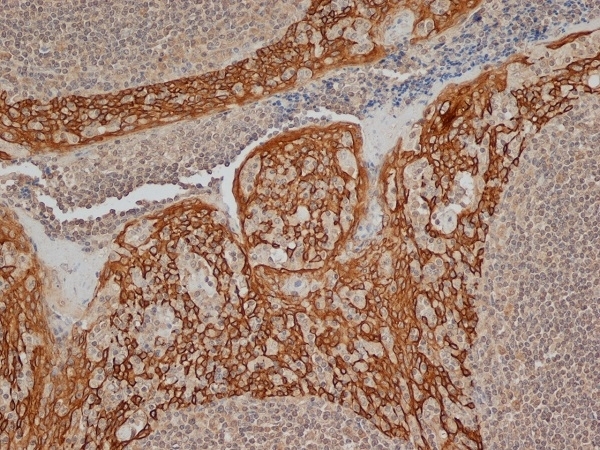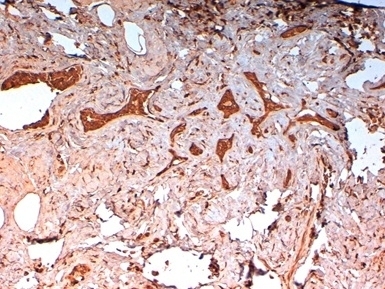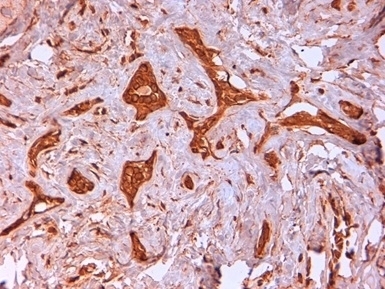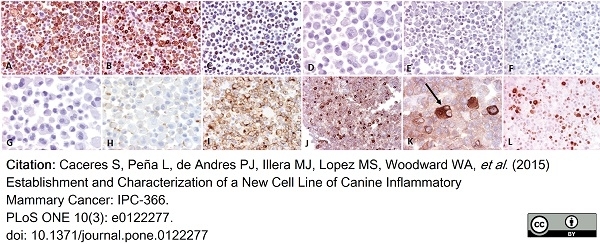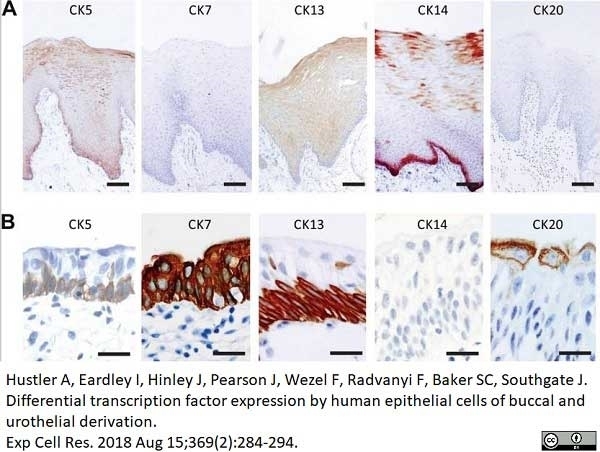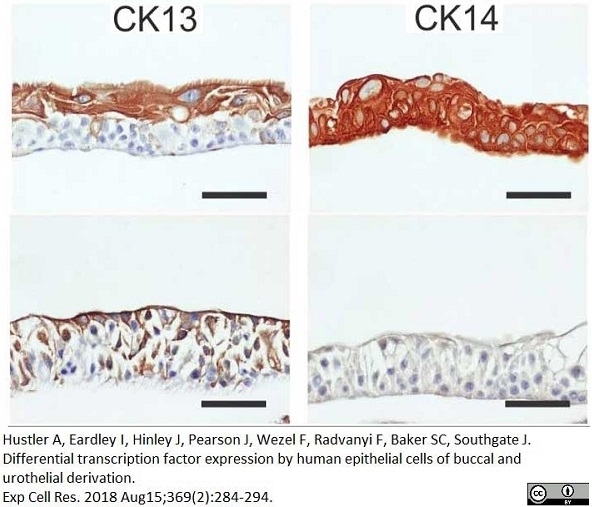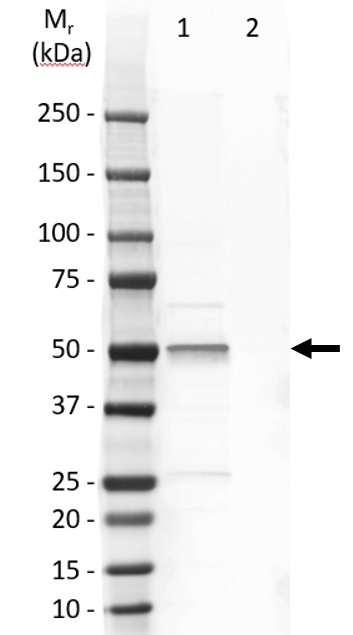Cytokeratin 14 antibody | LL002







Mouse anti Human Cytokeratin 14
- Product Type
- Monoclonal Antibody
- Clone
- LL002
- Isotype
- IgG3
- Specificity
- Cytokeratin 14
| Mouse anti Human Cytokeratin 14 antibody, clone LL002 recognizes cytokeratin 14, a type I intermediate filament, expressed by stratifying epithelial cells and can be used to distinguish these cell types from simple epithelial cells, which do not express cytokeratin 14. Mouse anti cytokeratin 14, clone LL002 has been reported to be suitable for use in Western blotting (Alam et al. 2011) |
- Target Species
- Human
- Species Cross-Reactivity
-
Target Species Cross Reactivity Elephant Dog Pig Lion - N.B. Antibody reactivity and working conditions may vary between species.
- Product Form
- Purified IgG - liquid
- Preparation
- Purified IgG prepared by affinity chromatography on Protein G from tissue culture supernatant
- Buffer Solution
- Phosphate buffered saline
- Preservative Stabilisers
0.09% Sodium Azide - Carrier Free
- Yes
- Immunogen
- Last 15 C-terminal residues of human cytokeratin 14 conjugated to thyroglobulin.
- Approx. Protein Concentrations
- IgG concentration 1.0 mg/ml
- Regulatory
- For research purposes only
- Guarantee
- 12 months from date of despatch
Avoid repeated freezing and thawing as this may denature the antibody. Storage in frost-free freezers is not recommended.
| Application Name | Verified | Min Dilution | Max Dilution |
|---|---|---|---|
| Flow Cytometry 1 | 1/100 | ||
| Immunofluorescence | |||
| Immunohistology - Frozen | |||
| Immunohistology - Paraffin 2 | 1/200 | ||
| Western Blotting |
- 1 Membrane permeabilization is required for this application. The use of Leucoperm (Product Code BUF09) is recommended for this purpose.
- 2This product requires antigen retrieval using heat treatment prior to staining of paraffin sections.Sodium citrate buffer pH 6.0 is recommended for this purpose.
- Flow Cytometry
- Use 10ul of the suggested working dilution to label 1x106 cells in 100ul.
- Histology Positive Control Tissue
- Skin
Source Reference
-
Purkis, P.E. et al. (1990) Antibody markers of basal cells in complex epithelia.
J Cell Sci. 97 ( Pt 1): 39-50.
References for Cytokeratin 14 antibody
-
Wetzels, R.H. et al. (1989) Detection of basement membrane components and basal cell keratin 14 in noninvasive and invasive carcinomas of the breast.
Am J Pathol. 134 (3): 571-9. -
Lane, E.B. & Alexander, C.M. (1990) Use of keratin antibodies in tumor diagnosis.
Semin Cancer Biol. 1 (3): 165-79. -
Munz, B. et al. (1999) Overexpression of activin A in the skin of transgenic mice reveals new activities of activin in epidermal morphogenesis, dermal fibrosis and wound repair.
EMBO J. 18: 5205-15. -
Stumpf, P. & Welsch, U. (2002) Cutaneous eccrine glands of the foot pads of the rock hyrax (Procavia capensis., Hyracoidea, Mammalia.).
Cells Tissues Organs. 171 (2-3): 215-26. -
Stumpf, P. et al. (2004) Cutaneous eccrine glands of the foot pads of the small Madagascan tenrec ( Echinops telfairi, Insectivora, Tenrecidae.): skin glands in a primitive mammal.
Cell Tissue Res. 315 (1): 59-70. -
Varley, C.L. et al. (2004) Activation of peroxisome proliferator-activated receptor-gamma reverses squamous metaplasia and induces transitional differentiation in normal human urothelial cells.
Am J Pathol. 164: 1789-98. -
Richardson, G.D. et al. (2004) CD133, a novel marker for human prostatic epithelial stem cells.
J Cell Sci. 117 (Pt 16): 3539-45. -
Stumpf, P. & Welsch, U. (2004) Secretory and defensive functions of the duct system of the lactating mammary gland of the African elephant (Loxodonta africana, Proboscidea)
Zoomorphology. 123 (3): 155–67
View The Latest Product References
-
Collins, A.T. et alet al. (2005) Prospective identification of tumorigenic prostate cancer stem cells.
Cancer Res. 65: 10946-51. -
Matos, A.J. et al. (2006) Detection of lymph node micrometastases in malignant mammary tumours in dogs by cytokeratin immunostaining.
Vet Rec. 158: 626-30. -
Faustino, A.M. & Dias Pereira, P. (2007) A salivary malignant myoepithelioma in a dog.
Vet J. 173 (1): 223-6. -
Holliday, D. et al. (2009) Novel multicellular organotypic models of normal and malignant breast: tools for dissecting the role of the microenvironment in breast cancer progression.
Breast Cancer Res. 11: R3 -
Eastman, R. .Jr. et al. (2010) Fibroblast growth factor-10 signals development of von Brunn's nests in the exstrophic bladder.
Am J Physiol Renal Physiol.299:F1094-110. -
Takahashi, C. et al. (2010) Newly established cell lines from mouse oral epithelium regenerate teeth when combined with dental mesenchyme.
In Vitro Cell Dev Biol Anim. 46: 457-68. -
Alam H et al. (2011) Loss of keratins 8 and 18 leads to alterations in α6β4-integrin-mediated signalling and decreased neoplastic progression in an oral-tumour-derived cell line.
J Cell Sci. 124 (Pt 12): 2096-106. -
Abdeen, S.K. et al. (2011) Wwox inactivation enhances mammary tumorigenesis.
Oncogene. 30: 3900-6. -
Clark, S.E. et al. (2011) Molecular subtyping of DCIS: heterogeneity of breast cancer reflected in pre-invasive disease.
Br J Cancer. 104: 120-7. -
Turner, A. et al. (2011) Transplantation of autologous differentiated urothelium in an experimental model of composite cystoplasty.
Eur Urol. 59: 447-54. -
Mwase, M. et al. (2013) Cutaneous Squamous Cell Carcinoma presenting as a Wound with Discharging Sinus Tracts in a Wild African Lion (Panthera leo).
J Comp Pathol. pii: S0021-9975(13)00106-0. -
Caceres, S. et al. (2015) Establishment and Characterization of a New Cell Line of Canine Inflammatory Mammary Cancer: IPC-366.
PLoS One. 10 (3): e0122277. -
Honda, K. & Tomooka, Y. (2016) Nerve-independent and ectopically additional induction of taste buds in organ culture of fetal tongues.
In Vitro Cell Dev Biol Anim. 52 (9): 911-9. -
Ogihara, K. & Madarame, H. (2020) Pancreatic adenosquamous carcinoma with invasion to the spleen in a cat.
J Vet Med Sci. 82 (9): 1395-9. -
Hustler, A. et al. (2018) Differential transcription factor expression by human epithelial cells of buccal and urothelial derivation.
Exp Cell Res. 369 (2): 284-294. -
Sakai, Y. et al. (2019) A clonal stem cell line established from a mouse mammary placode with ability to generate functional mammary glands.
In Vitro Cell Dev Biol Anim. 55 (10): 861-71. -
Yasuno, K. et al. (2013) Atypical canine mammary adenoma characterized by cystic ducts comprising a single layer of basaloid cells with myoepithelial differentiation.
J Vet Med Sci. 75 (8): 1095-9.
Further Reading
-
Moll, R. et al. (1982) The catalog of human cytokeratins: patterns of expression in normal epithelia, tumors and cultured cells.
Cell. 31 (1): 11-24.
- RRID
- AB_322015
- UniProt
- P02533
- Entrez Gene
- KRT14
- GO Terms
- GO:0005515 protein binding
- GO:0005739 mitochondrion
- GO:0005829 cytosol
- GO:0005200 structural constituent of cytoskeleton
- GO:0005634 nucleus
- GO:0008544 epidermis development
- GO:0031581 hemidesmosome assembly
- GO:0045095 keratin filament
- GO:0045110 intermediate filament bundle assembly
- View More GO Terms
Please Note: All Products are "FOR RESEARCH PURPOSES ONLY"
View all Anti-Human ProductsAlways be the first to know.
When we launch new products and resources to help you achieve more in the lab.
Yes, sign me up